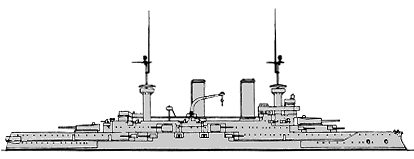
NAVYPEDIA
 Support the project with paypal
Support the project with paypal
Photo

Wittelsbach
Ships
| Name | No | Yard No | Builder | Laid down | Launched | Comp | Fate |
|---|---|---|---|---|---|---|---|
| Wittelsbach | 25 | Wilhelmshaven KW | 1899 | 3.7.1900 | 15.10.1902 | drill and depot ship 1916 | |
| Wettin | 676 | Schichau, Danzig | 1899 | 6.6.1901 | 1.10.1902 | drill and depot ship 1916 | |
| Zähringen | 86 | Germaniawerft, Kiel | 1899 | 12.6.1901 | 25.10.1902 | drill ship 1916 | |
| Schwaben | 27 | Wilhelmshaven KW | 1900 | 19.8.1901 | 13.4.1904 | drill ship 1916 | |
| Mecklenburg | 248 | Vulcan, Stettin | 1900 | 9.11.1901 | 25.6.1903 | prison ship 1916 |
Technical data
| Displacement normal, t | 12596 |
|---|---|
| Displacement full, t | 12798 |
| Length, m | 126.8 oa 125.2 wl |
| Breadth, m | 20.8 (22.8 by secondary turrets) |
| Draught, m | 8.04 |
| No of shafts | 3 |
| Machinery | Wittelsbach, Zähringen, Schwaben: 3 VTE, 6 Marine + 6 cylindrical boilers Wettin, Mecklenburg: 3 VTE, 6 Thornycroft + 6 cylindrical boilers |
| Power, h. p. | 14000 |
| Max speed, kts | 17.5 |
| Fuel, t | coal 1800 + oil 200 |
| Endurance, nm(kts) | 5000(10) |
| Armour, mm | belt: 225 - 100, deck: 50 with 120 - 75mm slopes, main turrets: 250, secondary turrets: 150, gunshields: 70, casemates: 140, CT: 250 - 140 |
| Armament | 2 x 2 - 238/37 SK L/40 C/98, 18 x 1 - 150/37 SK L/40 C/97, 12 x 1 - 88/27 SK L/30 C/89, 12 x 1 - 7.9/80, 6 - 450 TT (1 bow, 2 beam, 1 stern) |
| Complement | 683 |
Standard scale images

Wittelsbach 1904
Graphics
Project history
The Wittelsbach class were the first battleships to be ordered under Tirpitz's Navy Law of 1898 but marked no great step forward in German design as they resembled their predecessors in most respects, although the armour belt was rather more extensive.
Ship protection
Main belt had 225mm thickness between barbettes, tapering to 100mm at lower edge. Its thickness decreased to 100mm from fore barbette to stem and abreast aft barbette. After end of the waterline was unprotected. The belt had 100mm teak backing. Main 50mm protective deck was connected with lower edge of the belt by the slopes, 75mm-thick inside the citadel and 120mm-thick fore and aft. Main gun turrets had 250mm sides and 50mm crowns, secondary turrets had 150mm sides, casemates had 140mm protection, gunshields for 88mm guns had 70mm thickness. Main CT had 250mm sides and 30mm roof, aft CT had 140mm sides and 30mm roof.
Modernizations
None.
Naval service
By 1916 they were considered useless as fighting ships and disarmed. Zähringen was used as a target ship in 1917. After the end of the war she was hulked, but in 1926 she was converted to a radio controlled target ship, with only a two-shaft machinery installation. She was bombed and sunk at Gdynia (Gotenhafen) in 1944 and broken up where she lay. Wittelsbach and Schwaben were converted to depot ships for minesweeping motor launches, carrying 12 each, but they did not last long in this role.
 HOME
HOME FIGHTING SHIPS OF THE WORLD
FIGHTING SHIPS OF THE WORLD GERMANY
GERMANY CAPITAL SHIPS
CAPITAL SHIPS WITTELSBACH battleships (1902 - 1904)
WITTELSBACH battleships (1902 - 1904)
